Interview schedules or self-administered questionnaires are probably the most important and commonly used data-collection research instruments. The construction of these tools thus occupies a central position in any scientific investigation.
Learn About Questionnaire With This Full Guide
What is a Questionnaire?
A questionnaire is a formalized set of questions designed to obtain information from the respondents or the subjects selected for a study.
It is an instrument that is generally handed over to the respondents and filled in by them with no help from the interviewer or any other person.
Schedule
A schedule, also known as an interview schedule, is an instrument that is not given to the respondents but is filled in by the interviewer, who reads the questions to the respondents and records the answers as provided by the respondents.
Observational check-list
In addition to questionnaires and schedules, some studies seek information on the physical facilities, type of services rendered, management aspects, and day-to-day activities in an organizational setup.
For this purpose, some form of check-list is employed, called observational checklist. This checklist simply records items as it is physically found at the study locations, such as school, clinic, hospital, shopping mall, and other service centers.
The purpose of such a listing is to assess the adequacy of the instruments or items to ensure improved services to the clients.
Registration form
In most countries, registration forms (modules) are employed to record vital events such as birth, death, migration, marriage, etc. Bangladesh Bureau of Statistics (BBS) has a long history of recording such events in their sample vital registration areas throughout the country.
Opinionnaire
At the outset, let us define what an opinion is. The opinion is what a person says or feels to speak on certain aspects of the issue under consideration.
It is an outward expression of an attitude held by an individual. An individual’s attitude can be inferred or guessed from his or her statements of opinion.
On the other hand, an opinionnaire is defined as a form containing a list of statements, each of which the members of a selected group are asked to endorse or reject; the purpose is to gather information for a survey.
Opinionnaires are usually used in descriptive research, which demands a survey of the opinions of the individuals. Public opinion research is an example of an opinion survey.
The opinionnaire makes use of statements or questions on different aspects of the problem under study. The responses in such studies are expected either on three-point or five-point scales.
Respondent
A respondent is a person who provides information as asked by the interviewer.
Interviewer
An interviewer is a person in a face-to-face interview who seeks or records information provided by the respondents.
Characteristics of a Questionnaire/Schedule
A questionnaire has three specific characteristics.
- It must translate the information needed into a set of specific questions that the respondents can and will answer.
- It must uplift, motivate, and encourage the respondents to become involved in the interview and complete the interview.
- It should minimize the response as well as other types of errors.
Contents of Questions
The inquiries made in surveys may be concerned with facts, opinions, attitudes, respondents’ motivation, his/her knowledge on certain issues, and the like.
Most questions, however, can be classified in either of two general categories: factual questions and subjective questions.
Factual questions are fact-based, measurable, and observable.
These questions are designed to elicit objective information from the respondents regarding their background information that including such information as the respondents’ sex, education, occupation, religion, marital status, or social status.
Subjective questions elicit the respondents’ personal opinions, experiences, attitudes, beliefs, knowledge, interpretations, points of view, emotions, and personal judgment on any issue under investigation.
The factual information is used in a subsequent analysis in conjunction with the subjective behavior of the respondents.
For example, we may be interested to know whether males are more efficient in typing than their female counterparts. Here sex as a background variable may be examined to see if there is any sex differential in typing.
The following is an example of a factual question as asked in a survey:
- What is your current marital status?
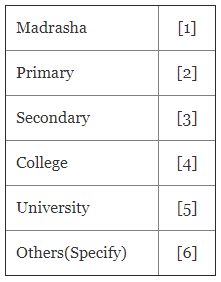
Consider another example that illustrates what a factual question is:
- What is your current marital status?
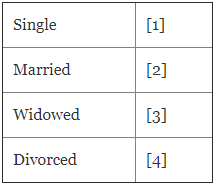
Subjective questions are designed to elicit the subjective experiences of the respondents directed towards ascertaining the respondents’ beliefs, practices, attitudes, knowledge, and opinions.
Here is an example that expresses the attitude
- The government has recently proposed to ban student politics on campus. Do you support this?

An opinion-related question may be framed as follows:
- The internet is superior to traditional libraries for a comprehensive search.
Each respondent was asked to react on the above issue, and his or her response on this particular issue was recorded in one of the 3-levels of the agreement. These levels of agreement, along with pre-assigned scores, are shown below:
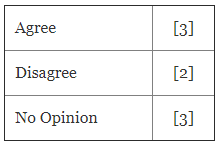
One can study this issue by questioning about the respondent’s background characteristics such as age, occupation, education, etc.
Types of Questions
Before elaborating on the steps involved in designing a questionnaire, we need to know the types of questions to be incorporated in a questionnaire, including their structure and format.
Depending on how questions are asked and recorded, we can broadly distinguish two types of questions:
- open-ended questions, and
- closed questions
Open-ended questions
A question that is formulated without pre-determined responses is open-ended. An open-ended question permits free responses that should be recorded in the respondents’ own words.
Here the respondents are not provided with any possible answers to choose from. Such questions are useful to obtain information on:
- facts with which the researcher is not very familiar or difficult to recollect;
- opinion, attitude, and suggestions of informants, etc. ;
- Sensitive issues.
Look at the following examples:
Qp What are the functions of a city Mayor? – (which is usually unfamiliar to many people and might have several responses)
Q2: How can be malnutrition among children reduced? – (we can expect several opinions on this issue).
The Client Satisfaction with Sterilization Procedure Survey of 1990 by NIPORT asked the Family Planning Fieldworkers the following question:
Q: In your opinion, how can the satisfaction of acceptors of sterilization increase?
Open-end questions have at least two advantages:
- It allows the respondents to “tell it like it is” in his/her own words.
- It may provide valuable new insight into the problem relating to the issues not previously thought of at the planning stage.
The disadvantages of the open-end question, among others, are
- It may lead to distorted information when the interviewers are unskilled.
- The analysis is time-consuming.
Closed questions
A closed question, on the other hand, is one that offers a list of possible options or answers with fixed alternatives, from which the respondents must choose.
Closed questions are useful if the range of possible responses is known and limited. Consider the following question which might have possible responses:
Q1: What is your marital status?
In response to this, the respondent will check one of the following:
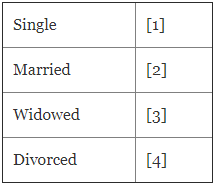
Closed questions may also be used to make respondents express their opinion by choosing points on an attitude scale:
Q2: The Internet is superior to traditional libraries for a comprehensive search.
The response categories are designed as follows:
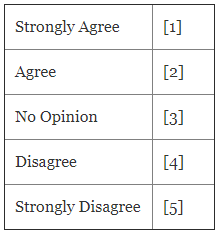
While framing closed questions,
- One should always offer a list of options (answers) that are exhaustive (i.e., cover all possibilities) and mutually exclusive (i.e., anyone option chosen excludes all others).
- The number of options should be kept at a minimum.
Closed questions have the following advantages:
- In closed questions, answers can be recorded quickly.
- The analysis is relatively easier.
The disadvantages of closed questions are:
- Unsuitable for a face-to-face interview.
- Options provided in the questionnaire may lead to bias.
- Some important information may be missed if it is not asked.
In practice, a questionnaire usually has a combination of open-ended and closed-form, arranged in such a way that the discussion follows as naturally as possible.
For open-ended questions, multiple-response is are usually allowed. The interviewers, in such cases, will not be in a hurry to skip to the next question.
He should be trained to wait for an additional answer that the respondent may provide. For closed questions, too, the interviewer must choose to tick the most appropriate answers.
Contingency question
In many instances, questions that are relevant to some respondents may be irrelevant or not applicable to others.
When you find that a woman is unmarried, asking her about the number of children she has is redundant.
A contingency question-a special case closed question-applies only to a subgroup of respondents.
The investigator determines the relevance of the question to this sub-group by asking all respondents the preceding filter question.
For example, in the client satisfaction survey, the filter question might be
- Have you ever attended school?
The contingency question could be
- What was the highest class you have passed?
The relevance of the second question to the respondent is contingent upon his or her responses to the filter question.
Only when the respondent says “Yes” to the first question will they respond to the second question. The survey designed questions as follows:
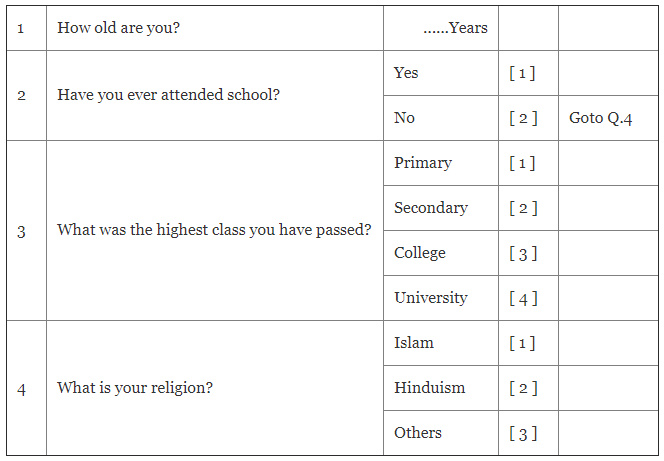
Matrix question
A matrix question is a method of organizing a large set of rating questions that have the same response categories. The following is an example that shows what a matrix question is:
- Which of the following methods of family planning have you heard of?
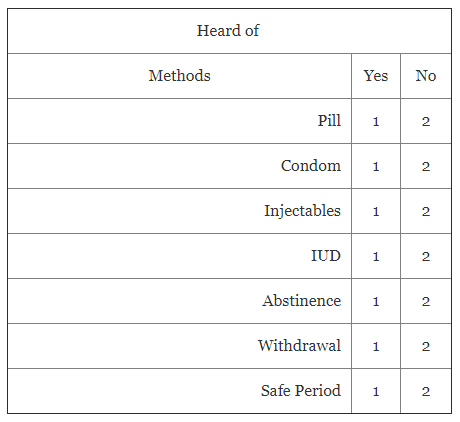
Consider another question: “What, in your opinion, is the most effective way of promoting sales in a department store?” The answers can be arranged in a matrix format as follows:
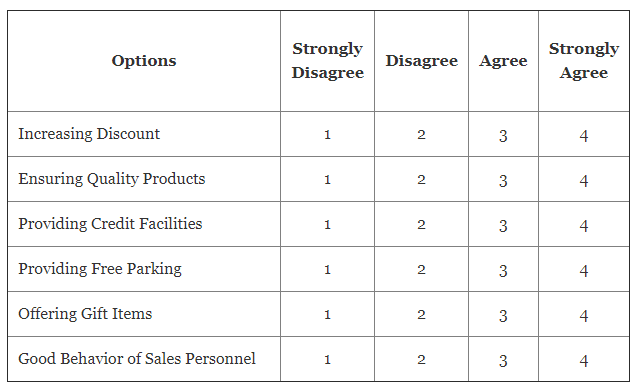
The respondent is free to choose multiple opinions.
Pre-coded and post-coded questions
A question may again be either pre-coded or post-coded. A pre-coding scheme may be followed for closed questions, such as for sex. Thus, you may designate the male by a numerical code “1” and the female by “2”.
You may do the other way round: “l” for females and “2” for males, but the former is the most common practice.
The question is kept open when possible answers cannot be exactly comprehended in the pre-coding scheme.
After getting the responses from the field, the answers are arranged in a logical order, and then numerical codes are assigned to each selected response. This is post-coding.
Main Considerations in Designing a Questionnaire
Once the decision has been made to use a particular format, the following questions should be considered before designing the questionnaire:
- What exactly do we want to measure according to the objectives formulated and the variables identified?
- To whom will we ask questions?
- Will the respondent willingly answer this question, as asked?
- Are the respondents mainly illiterate?
- Are ethical issues involved in this question?
- How large is the sample that will be interviewed?
The above questions are raised to ensure that the contents of the questionnaire are relevant to them;
- goals of the study, and
- individual respondents.
In a sample survey, it is customary to employ structured interviews rather than unstructured ones since the former lend themselves better to quantitative analysis, and the latter creates serious data processing difficulties, particularly if the die sample is large.
A structured interview employs a standard questionnaire (or interview schedule) to ensure that all respondents are asked the same set of questions in the same sequence.
The exact wording of each question is specified in advance, and the interviewer merely reads each question to the respondent. This is also true for the survey when information is sought by mail questionnaire.
The questioning of persons is an imposition and invasion of privacy, so it should not be surprising that some persons do not respond as we expect.
In dealing with this problem, there are several points to remember concerning the questionnaire contents and wording of the questions.
We discuss a few of these points.
Use simple language
Use simple and everyday language that the respondents will understand.
For example, instead of using ‘assist,’ ‘help’ is known to be a much-used word. Similarly, the words’ end’ in place of ‘terminate,’ ‘buy’ in place of purchase’, and the like are easier to apprehend.
Start with an interesting and easy question.
Respondents are likely to be somewhat tense or even suspicious at first, and the major task of the interviewer during the first few minutes is to establish rapport to place the respondent at ease.
Therefore, it is important to start with a question that is interesting and non-controversial, and directly related to the study.
This type of beginning should help to raise the respondents’ interest and lessen suspicions concerning the purpose of the study.
Such an approach is sometimes referred to as the funnel approach.
It is a technique in questionnaire construction that entails beginning with general questions to put the respondents at ease and then ‘funneling down’ to more specific questions.
Use short questionnaire
Do not overload the questionnaire with items that are not essential for your study. Make the questionnaire as short as possible.
If a long interview is presumed, interview two or more parts.
Avoid double-barrel questions
The double-barrel question refers to the inclusion of two or more questions in one. Consider the question:
- Does your government have a special recruitment policy for tribal people and women?
How does the respondent react to this question when his government has a policy to recruit tribal people but not women?
A “No” answer will mean that the government recruits neither group, while a “Yes” implies that the government has a recruiting policy for both groups.
Such a question typically leads to hesitation and indecision on the part of the respondents. Similarly,
- Do you and your husband want another child?
- Did you find Mr. Noman’s lecture interesting and useful?
– are two more examples of double-barrel questions.
Avoid ambiguous questions
An ambiguous question has more than one possible interpretation.
Here is a basic example:
- Did the lady hit the man with an umbrella?
The two possible interpretations are as follows:
‘Is the lady using an umbrella to hit the man?’ or ‘is she hitting the man carrying an umbrella?’
Avoid questions with vague words.
Vague questions invite vague answers. Words like ‘often,’ ‘fairly,’ ‘occasional,’ ‘frequently,’ and ‘on the whole’ are vague and should be avoided.
Avoid leading questions
A leading question is one, by its content, structure, or wording, that leads the respondents in the direction of a certain answer. An example of such a question is
- Smoking is harmful, isn’t it?
The answer is most likely to be “Yes.” Likewise, the question, - Do you agree that the Health Officer should visit the local Health Centre regularly?
Such a question hardly leaves room for ‘No’ or other options and thus is a leading question.
Avoid presuming questions
Questions should not, generally speaking, presume anything about the respondent. Question like
- How many cigarettes do you smoke daily?
It is a presumed question on the ground that the interviewer has assumed that the respondent is a smoker.
Avoid hypothetical questions
Hypothetical questions do not provide a great deal of information; generally, people find them quite difficult to answer and sometimes treat them funny and avoid answering.
They merely demonstrate the predictive behavior of the respondent and thus are of little significance. Question of the form
- Would you like to become the president of the country?
-is a hypothetical question.
Avoid questions that involve memory.
For many people, events that have occurred in the distant past are sometimes difficult to recollect. For example,
- How many times did you experience load shedding during the last 12 months?
Avoid sensitive, threatening, or embarrassing questions.
Sensitive, threatening, or embarrassing questions may include the respondents’ gambling habits, drinking, or sexual preferences. Such questions should be worded as tactfully as possible, and avoid asking them at the beginning of the interview.
Give the respondent a chance to relax and then ask questions on any sensitive or embarrassing issues relevant to your objective.
For example, “Are you a drug user”? is a sensitive question, and its answer is difficult to obtain.
Randomized response techniques may be employed to deal with such questions. Similarly, painful questions should also be asked with great care. Offensive questions should be avoided as far as possible.
Maintain sequencing of the questions
The sequence of the questions must be logical for the respondent and allow as much time as possible for a “natural discussion,” even in more structured interviews.
To maintain the sequence, it is rewarding to keep questions on background variables (e.g., education, marital status, occupation, income, etc.) at the beginning of the questionnaire as minimum as possible. These are personal information that people are reluctant to answer.